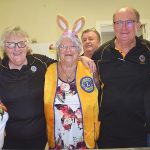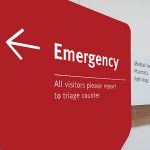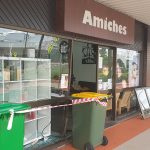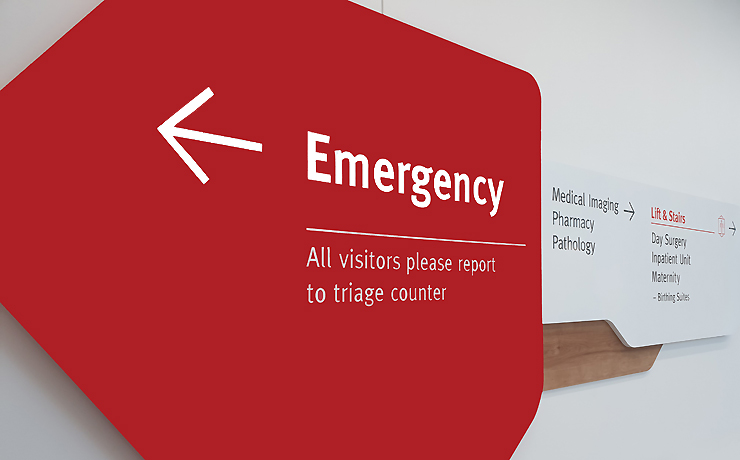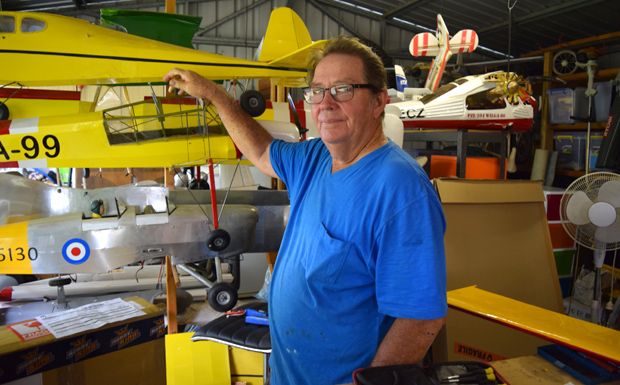
March 28, 2017
When Bill Larsen was a boy, his first love was building model aeroplanes.
But then women came into his life, followed soon afterwards by a family and everything that went with that, so he put aside his hobby for what turned out to be the next 20 years of his life.
But one day when he was in his 40s and the strains of parenthood had eased up a bit, Bill rediscovered the first true love of his life.
And these days he’s happily passing on the experience he’s gained from 40 years of building all sorts of model aeroplanes to fellow members of the Nanango & Districts Aeromodellers Club.
Last week Bill was in a shed he’s built at the rear of his Nanango home along with four fellow club members, teaching them how to build trainer planes from kits.
“The kits aren’t very expensive but the instructions are pretty awful, so I’m teaching the guys how to put them together so they’ll get a working plane they can fly on our club’s airfield,” Bill said.
“What they also learn through doing this is how to carry out repairs when the planes crash.
“If you’re an aeromodeller, you get to see a fair few of those over time.”
Bill’s shed is a testament to his love of the hobby.
A huge assortment of model aeroplanes hang from hooks and stands – some models of warplanes, some models of light aeroplanes.
He even has a model of a Wright brothers bi-plane that he originally bought as a present for his then-10 year old son, which is powered by a rubber band.
“I was going to give it to him but when I looked at it I realised it probably wouldn’t stay in one piece very long. So I kept it and got him something else instead,” Bill laughed.
A bench at one side of the shed is used for aeroplane assembly, and Bill’s students were hard at work last week putting wings on their planes by heat-sealing the plastic skins over balsa wing-frames with a small heating iron.
Has the technology changed very much since he was a boy?
“Yes, electronics has changed everything,” Bill said.
“When I first took up the hobby all the model aeroplanes were powered by motors that needed to be fuelled up. But thanks to electronics, the motors these days are much more lightweight and the power comes from rechargeable batteries.”
Radio controls for the planes have been revolutionised too, and once-bulky control sets now fit easily in a pilot’s hands.
Is aeromodelling an expensive hobby to get into?
“That depends on how you want to approach it,” Bill said.
“You could buy a plane kit for $80, a battery for $20 and a radio controller for maybe $100. Or you could go the other way and buy top-of-the-range gear that would cost a lot more.
“But we let potential new members come out to our airfield and try their hand at flying some of our planes for nothing to see if they like it, so you could say the real entry cost of aeromodelling is zero.”
Is it difficult to fly a model aeroplane?
“It usually takes something between 6 and 10 flights to learn how to use a radio controller properly, and maybe 20 flights before it’s second nature and you don’t really have to think about it any more.
“Most people pick it up, but there are always some that don’t.
“I guess we’re all good at different things.”
So where’s the club’s airfield?
“Our airfield is in Smith’s Road on a farming property behind South Burnett Quarries at Hodgeleigh North Road in Nanango,” Bill said.
“There’s nearly always someone about every Sunday, and anyone who’s interested in finding out more about aeromodelling or having a try at flying a model aeroplane is always welcome to come along.
“We have about 42 members, and one of the club’s specialties is that we like to build our own planes and show each other how to do it.”
Potential new members are also welcome to ring the club’s president Barry Sheppard on (07) 4163-1485.
Bill believes the Nanango & District Aeromodellers are the largest model aeroplane club in the South Burnett, and says a large part of the credit for that has to go to the Heritage Community Branch in Nanango.
“Over the years Heritage have given our club tremendous help,” Bill said.
“They helped us buy a tractor, then a ride-on mower, and then the two containers we use at the airfield as our club rooms.
“Last year they even helped us buy a portaloo, which made life a lot easier on the airfield.
“I can’t speak too highly about them.”








